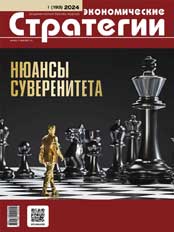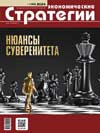Development Strategy for a Housing and Utilities Company
DOI: 10.33917/es-1.193.2024.138-143
The article dwells on the state of the regional housing and communal services and its individual enterprises, identifies therole of developing strategic models (competitive, adapted, situational) for their evolution. Attention is made to the need to coordinate housing and utility development strategies in the region as a whole and specific housing and communal services enterprises. A model of consistent strategic development of housing and utility companies is proposed, positive and negative aspects of the strategy of housing and utility enterprises, as well as internal and external factors are highlighted.
References:
1. Provalenova N.V. Organizatsionno-ekonomicheskoe razvitie sfery zhilishchno-kommunal’nykh uslug v malykh munitsipal’nykh obrazovaniyakh: dis. …d-ra ekon. nauk: 08.00.05. [Mesto zashchity: Ros. ekonom. un-t im. G.V. Plekhanova] [Organizational and Economic Development of the Sphere of Housing and Communal Services in Small Municipalities: Dis. … Doctor of Economics Sciences: 08.00.05. [Place of protection: Ros. economy University named after G.V. Plekhanov]]. Moscow, 2018, 293 p.
2. Kozlova S.V., Gribanova O.M. Povyshenie kachestva gosudarstvennogo upravleniya zhilishchno-kommunal’nym khozyaystvom [Improving the Quality of Public Management of Housing and Communal Services]. ETAP: ekonomicheskaya teoriya, analiz, praktika, 2016, no 4, pp. 134–143.
3. Blinov A.O., Ugryumova N.V. Upravlencheskie aspekty razvitiya sotsial’no-ekonomicheskikh sistem ZhKKh [Managerial Aspects of the Development of Socio-economic Systems of Housing and Communal Services]. Vestnik UGUES. Nauka, obrazovanie, ekonomika. Seriya: Ekonomika, 2015, no 1(11), pp. 51–55.
4. Makarova V.I., Bogdashkin Yu.N., Eliseeva I.V. Protsess razrabotki i realizatsii strategii zhilishchno-kommunal’nogo khozyaystva strany [The Process of Developing and Implementing the Country’s Housing and Communal Services Strategy]. Vestnik Volzhskogo universiteta im. V.N. Tatishcheva, 2016, no 2(3), pp. 148–154.
5. Stakhanov D.V. Strategicheskoe upravlenie zhilishchno-kommunal’nym khozyaystvom (ZhKKh) kak sotsial’no-ekonomicheskoy sistemoy [Strategic Management of Housing and Communal Services (HCS) as a Socio-economic System]. Vestnik Taganrogskogo gosudarstvennogo pedagogicheskogo instituta im. A.P. Chekhova, 2014, no 1, pp. 108–112.
6. Kemaykin N.K., Pavlenkov M.N. Napravleniya razvitiya ZhKKh Rossii [Directions for the Development of Housing and Communal Services in Russia]. Vestnik Tomskogo gosudarstvennogo universiteta. Ekonomika, 2020, no 51, pp. 21-34, DOI: 10.17223/19988648/51/2
7. Leus I. Sistema monitoringa innovatsionnoy i investitsionnoy deyatel’nosti zhilishchno-kommunal’nogo khozyaystva [System for Monitoring Innovation and Investment Activities of Housing and Communal Services]. Natsional’nye interesy: prioritety i bezopasnost’, 2015, no 4(289), pp. 23–42.
8. Petrova A.N. Strategicheskiy menedzhment [Strategic Management]. Seriya: Uchebnik dlya vuzov. Saint Petersburg, Piter, 2005, 496 p.













